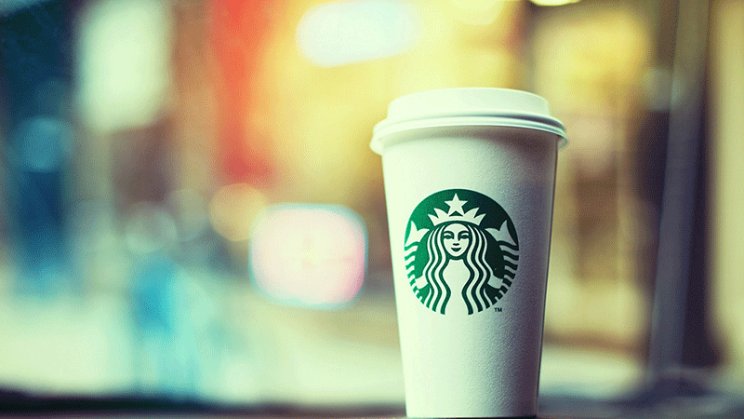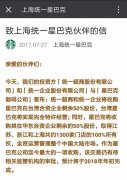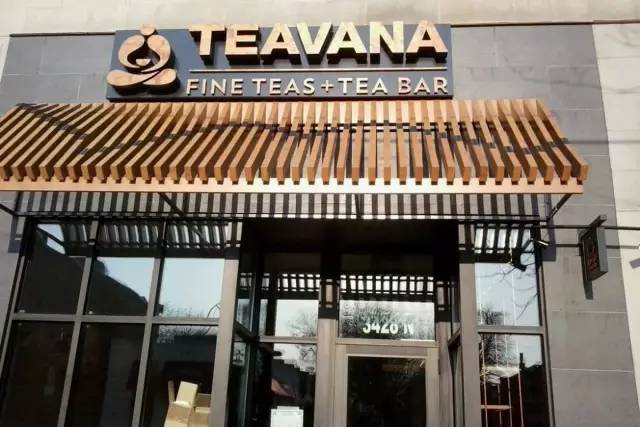What does it mean for Unification that Starbucks wants to take back control?
Follow the caf é (Wechat official account vdailycom) and found that Beautiful Cafe opened a small shop of its own.
Last night, July 27, Starbucks announced that it had formally reached its largest acquisition agreement to date with its long-time joint venture partners Uni-President Enterprise Co., Ltd. ("Uni-President") and Uni-President Superstore Co., Ltd. to recover the remaining 50% of Starbucks East China Market Joint Venture (Shanghai Unified Starbucks Coffee Co., Ltd.) with $1.3 billion in cash.
In other words, after the acquisition, Starbucks will wholly own about 1300 Starbucks in Shanghai, Jiangsu and Zhejiang (East China). At the same time, all 2800 stores in mainland China, including East, South and North China, have become Starbucks direct operations.
This means that the Starbucks China market will be wholly owned and managed by Starbucks itself, just like the US market.

Why did Starbucks change its strategy?
Starbucks' biggest concern is a slowdown in sales, according to AB Mendez and John Lutz, senior research analysts at Frost Investment Advisors.
And in the past few quarters, Starbucks has indeed failed to deliver results that satisfy the capital markets. Neither global same-store sales nor revenue met analysts' expectations, so much so that Starbucks announced that it would no longer include its target in its financial results.
The mediocre performance of the domestic market in the United States and the market shocks after Brexit have left Starbucks in a rather passive situation.
But these concerns can be mitigated as products diversify and stores expand. China has become a growth market with high hopes. As Chinese consumers have been trained to drink coffee or drink more coffee, the number of transactions at Starbucks has increased by 6%, resulting in a 7% increase in same-store sales in the Chinese market. Of the more than 1000 new stores opened in the Asia-Pacific region in the past year, the biggest credit also belongs to China, where consumption is expanding rapidly.
That's why Starbucks has repeatedly stressed its plans to open stores in China since the acquisition agreement was announced last year. In this future defined by Starbucks as the world's largest single market and the most important market, Starbucks wants to regain control.
Another set of data also shows more clearly why Starbucks changed its strategy. Let's make a simple calculation: according to Starbucks' just released third-quarter results, revenue in China / Asia Pacific is $840 million, of which 2800 stores are equivalent to a store earning $300000; Starbucks' overall global revenue is $5.6615 billion, with a total of 21000 stores and a store earning $270000. In other words, the profitability of the Chinese market is higher than the global average.
There is no doubt about the importance of East China to the Chinese market, accounting for nearly half of the number of stores in the Chinese market. Among them, Shanghai alone has nearly 600 stores, making it the city with the largest number of Starbucks in the world. It is also the first city in Starbucks' overseas market to have a Starbucks baking plant.
Starbucks Shanghai Xintiandi Store
But setting up a joint venture first and gradually taking back control when the time is ripe is the usual pattern for Starbucks to enter overseas markets. In 1995, Starbucks established a joint venture with Sazaby League, a local Japanese company, and officially entered the Japanese market, with Sazaby League holding a 39.5% stake. After spending enough time learning and understanding the local market, Starbucks spent $913.5 million to take back the remaining 60.5% of its shares in September 2014. After working with Japanese companies for about 20 years, Starbucks learned the "rules". In Japan, it learned to launch Japanese-style fortune bags in January each year, giving coffee vouchers and thermos and other gifts; it learned to work with Suntory to launch coffee and enter convenience stores ubiquitous in Japan.
Starbucks replicated the same model when it entered the Chinese market in 1999. The agency of Hong Kong and Guangdong has been granted to the Hong Kong Meixin Group, the northern region of Beijing and Tianjin has been awarded to Beijing Meida Coffee Co., Ltd., and the agency of Taiwan and Jiangsu, Zhejiang and Shanghai has been awarded to the Taiwan Unification Group. At first, Uni-President owns 50%, Uni-President holds 45%, and Starbucks only holds 5%. In most of Starbucks' overseas investments, the initial investment of 5% is its usual strategy. By giving local companies control most of their operations and capital, Starbucks avoids a lot of risk while maintaining links between headquarters and overseas companies. As Starbucks learns about the local market and, as policy permits, Starbucks will gradually withdraw its control of its stores.
In 2005, after the sole proprietorship of foreign enterprises was allowed in mainland China, Starbucks gradually changed the authorization and cooperation strategy of the mainland market into direct operation. In 2006, Starbucks recovered 90% of its stake from Meida Coffee and became wholly owned in north China; its stake in Maxine Starbucks has also risen to 51%.
In 2003, Starbucks bought a total of 45 per cent of Shanghai's Starbucks from Uni-President and Uni-President, but at that time it spent only Rmb176 million, compared with $1.3 billion today.
The deal is subject to regulatory approval and is expected to be completed early next year.
What does it mean for unification?
It seems inappropriate for Uni-President to abandon Shanghai Starbucks, which has just the right momentum.
The relationship between Unification and Starbucks has a long history. As early as 1997, Unification introduced Starbucks to the Taiwan market, and in 2002, Unification introduced Starbucks to mainland China. In East China, Shanghai's performance is particularly outstanding. When Starbucks entered Taiwan, it lost money for three years, while when it entered Shanghai in May 2000, Shanghai Starbucks began to make a profit in only one year and nine months. In the first complete fiscal year in 2001, the revenue of Starbucks in Shanghai reached more than 60 million yuan and more than 100 million yuan in 2002.
At that time, Unification Group was in full swing in Taiwan, with food manufacturing, circulation, finance and other related industries under its control. In the late 1990s, Gao Qing, president of Unification Group, ranked fifth among the most respected entrepreneurs and was called the "entrepreneur who changed life in Taiwan."
Starbucks chose to cooperate with Uni-President and mainly took a fancy to the Uni-President Shang Chao under the Unification Group. When the joint venture was announced in 1998, Xu Chongren, then general manager of Uni-President Superstore, pointed out that Uni-President supermarket had successful experience in chain operation, so it was confident that it would create another successful experience in the coffee chain market.
Taiwan-Chongqing South Road stores
However, the obvious decline of Unification in the mainland market may be one of the main reasons why Starbucks abandoned Unification.
According to the 2016 results of Uni-President, the revenue of Uni-President China Holdings Limited (hereinafter referred to as Uni-President), which is in charge of mainland China business, was 20.986 billion yuan, down 5.1% from the same period last year. And the revenue of Uni-President has declined for three consecutive years. In addition, its profit in 2016 was 607 million yuan, down 27.22% from the same period last year.
Since last year, Uni-President has also been streamlining its business. In May last year, for example, Uni-President sold a 47.83% stake in Jinmai Lang Beverage for 1.291 billion yuan. In November 2016, Uni-President Group sold its 100% stake in Foshan Sanshui Jianlibao Trading to Jianlibao Group for 950 million yuan. But these are all businesses that are a drag on performance.
In the deal, Uni-President and Uni-President will buy the remaining 50 per cent of Taiwan's Uni-President Starbucks for about $175 million and own 100 per cent of Starbucks in the Taiwan market.
But when you compare the performance of Shanghai Unification Starbucks and Taiwan Unification Starbucks, it is easy to see the difference.
Shanghai Unified Starbucks has been expanding at an extremely rapid rate, opening its first store in Shanghai in 2000, and in its 2016 results, they expect the number of stores to exceed 1500 in 2017. Along with the number of stores, the profits of Shanghai Unified Starbucks rose from 631 million yuan last year to 921 million yuan this year.
For Unification, however, such an expansion strategy has nothing to do with it.
At the press conference, Uni-President Luo Zhixian did not directly answer whether the sale of the stake was because Starbucks wanted to recover the fast-growing mainland market, but only stressed that it would integrate resources and dig deep into the Taiwan market. "the main consideration is the vigorous development of the coffee market around the world in the future. We should be more specialized and consistent in thinking about the organization and resources."
By contrast, Taiwan's Unification Starbucks' profit fell to 79 million yuan from 184 million yuan last year. Chen Ruitang, general manager of Uni-President, said in March that the growth of Taiwan's Starbucks has slowed to tie in with Starbucks' loyalty program in the United States, but Taiwan's profits are still far lower than those of Shanghai Unified Starbucks.
However, for Unification, taking complete control of Starbucks may be more helpful for them to improve the performance of the Taiwan market. At present, Uni-President Starbucks has a market share of about 10% in Taiwan's coffee market, which is worth about 15.6 billion yuan. The number of coffee cups per capita in Taiwan has increased from 55 cups in the past to 120 cups, but the number in mature markets such as Japan and South Korea is more than three times that of Taiwan, which means that Taiwan's coffee market still has room for growth.
Tea failed because Starbucks ignored the force of space.
Starbucks used the $40 billion tea beverage market as a huge gold mine, spent $620 million in cash to acquire premium tea group Teavana, and then raised the market valuation to $100 billion. "buying Teavana will allow us to break and lead the market, just like we did with expresso 30 years ago," said CEO Schultz at the time.
Schultz said in 2012 that there was a return of $3 for every $1 invested in Teavana.
Even China expressed optimism: "China's tea market has great potential, so Chawana is Starbucks' strategic focus in the tea field." In the next five years, we will effectively implement our development plan, and the total tea business is expected to increase to US $3 billion.
It turns out that Starbucks mistakenly linked tea culture to its profitability. One of its mistakes is that it ignores its strong point: the "third space".
Teavana was acquired with a wide range of sales channels as its main selling point, but more than 500 retail outlets are Teavana store, which sells canned tea in department stores. After the acquisition, Starbucks opened five Teavana tea bar on the street.
The common reason for the failure of Teavana analysis is that its culture can not be integrated into the United States, but in fact, it is because of its success as a tea retail that Starbucks has attracted acquisitions. The real reason for the decline is that the flow of people in American department stores has fallen sharply in recent years, and the same-store sales of Teavana store have declined, resulting in loss-making operations.
Unfortunately, the practice of not opening independent stores has been adopted in China, and when promoting "iced shaken peach green tea" and "iced shaken grapefruit honey black tea", Starbucks only showed up on the original store product board, resulting in the Teavana experience and brand presence close to zero-Starbucks's most persuasive in China, but also as a "third space" experience.
Because of the lack of space, consumers directly compare the two Teavana tea drinks with other tea brands, while the former is not very competitive in taste and price. Some consumers have criticized that the taste of these two kinds of tea is too light, and "more than half of them are ice cubes."
Two Teavana tea drinks specially developed by Starbucks for the Chinese market
In January last year, Starbucks closed four of its Tea Bar stores to operate coffee stores, and the only one left was the Seattle store, where it is headquartered. Teavana's drinks and teas are sold in Starbucks stores, and the decision to close 379 Teavana store will affect 3300 employees.
Teavana Store
New competitor, who is poaching Starbucks?
However, Starbucks is now facing a far more complex Chinese market than it was able to grow rapidly by relying solely on its expansion strategy. Starbucks is not the only coffee brand to expand its stores in the Chinese market. Its competitors include not only European and American coffee brands such as Costa and Pacific, but also local boutique cafes scrambling to rapidly expand the Chinese market after the fame of Korean coffee.
Seesaw, which received 45 million yuan in A-round financing from Hony Capital in June, has opened 10 cafes in Shanghai and Shenzhen in the past few years, and then expanded to Beijing, Hangzhou and other places. Malone Coffee has expanded rapidly from one store to more than 20 since 2016. The quality pavilion opened by Taiwan advertiser Zheng Songmao claims to rely on the O2O e-commerce platform to land 1000 franchise stores in China, and hopes to seize the low-line market before the market breaks out.
Compared with these boutique cafes, Starbucks has gradually lost its charm as a coffee educator in the hearts of consumers in first-tier cities.
One of Starbucks' countermeasures is to introduce new products frequently and shorten the time difference between different markets. The gas-cooled extract with nitrogen is on sale in China and the United States at almost the same time. It is generally believed that in the future, Starbucks is likely to develop products specifically for the Chinese market.
In addition, the diversified product line has also become a way to increase same-store revenue.
In early July, on the 25th anniversary of Starbucks' Nasdaq listing, Scott Maw, Starbucks' chief financial officer, said Starbucks' top priority was to increase food as a percentage of total revenue. Although Starbucks breakfast is doing well, lunch is an important part of their future food business growth.
Starbucks China has increased the proportion of lunches since last year. Although Starbucks coffee has a gross profit margin of about 80% and only 50% of food, Starbucks sells food on the basis of its original manpower and material resources, and selling food actually helps to boost store profits. In addition, selling food can also offset the cost of a low turnaround rate behind simply selling coffee.
Another thing that Starbucks is wary of is the rise of a new generation of tea chains in China. They seem to belong to different areas of competition, but they pose a threat to the diversion of customers in terms of consumer budgets and potential locations.
More importantly, this wave of tea chains is shaping a new consumer culture. Teavana and similar tea chains have not made great progress in China, and the vitality, speed of change and ability to grasp young consumers of street brands are precisely the shortcomings of Starbucks.
Important Notice :
前街咖啡 FrontStreet Coffee has moved to new addredd:
FrontStreet Coffee Address: 315,Donghua East Road,GuangZhou
Tel:020 38364473
- Prev

Chinese mainland is the largest acquisition in the company's history, and the Starbucks market will be fully and directly operated.
Following Kaipai (Wechat official account vdailycom) found that how much is a Starbucks store worth at Beautiful Cafe to open its own small shop? On the evening of the 27th, Starbucks broke the news that it would buy the remaining 50% of Starbucks' joint venture in East China market for about $1.3 billion in cash. 100% ownership of about 1300 stores in Jiangsu, Zhejiang and Shanghai, that is, Starbucks China
- Next

Starbucks announced today that it will close all Teavana stores.
Starbucks today announced revenue for the last quarter, which was in line with analysts' expectations, but Starbucks predicted that business would be a bit sluggish this quarter and announced that it would close 379 Teavana stores nationwide by the spring of 2018. The announcement comes after Starbucks announced that it would buy a 50% stake in its business in eastern China from its partners.
Related
- Why are the coffee in some coffee shops not enough after being frozen? What should I make up for my American latte cappuccino coffee after being frozen?
- How much water does it take to steam coffee by hand? Why is the coffee brewing and steaming time 30 seconds? What is the purpose of steaming coffee?
- The suspected drink contains too much caffeine! Overlord Tea Lady responds urgently!
- Starbucks rejects antique paper coupons?! Netizen: Missed marketing opportunities!
- What ratio of water temperature and ground does the smart cup method use to press coffee? The difference between brewed coffee and filtered coffee?
- What is the standard process for the purpose of coffee cup testing? What is the difference between hand-brewed coffee and cup testing?
- How to use hand-brewed coffee paragon small golden balls? How does cold coffee lock in the aroma of coffee?
- Is American coffee black? What is the difference between American coffee and drip coffee?
- Unexpected! Well-known tea beverage brand Lele Tea will withdraw from the Zhengzhou market!
- Starbucks enters the fashion and beauty industry?! Netizen: Give me an ice American eye cream

